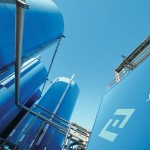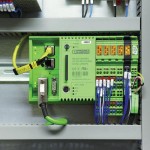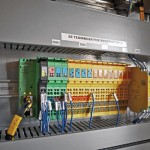FeF Chemicals was looking for a reliable solution to enable it to discharge unpolluted rainwater from the company’s expansive grounds into the Baltic Sea. Should the water become contaminated with damaging substances, the pumps have to be stopped immediately. The Danish supplier to the pharmaceutical industry also required a high degree of availability. For this reason – and because of economic aspects – they chose Phoenix Contact’s SafetyBridge technology.
The author: Lutz Rahlves Product Marketing Safety, Phoenix Contact Electronics
FeF Chemicals A/S, a wholly owned subsidiary of the Danish Novo Nordisk A/S Group, is a globally leading supplier of high-quality quaternary ammonium compounds (quats) and a key vendor of insulin for cell culture processes. Its various products are manufactured in numerous buildings that are distributed around the expansive company grounds. The company, which is located south of Copenhagen in the town of Koege, is directly adjacent to a nature reserve and the Baltic Sea. It consequently makes sense if all rainwater falling on the site can be discharged into the Baltic. In normal operation, this certainly doesn’t represent a problem for the environment. However, some of the substances processed in the individual production facilities are highly toxic. If one of the tanks were to develop a leak, then the chemicals could be washed into the adjacent nature reserve through the rainwater system and thus threaten the plant and animal life there.
Safe and flexible solution
To protect the environment, surface water is therefore not directly discharged into the Baltic, but buffered in tanks and then subsequently pumped out to sea. If a dangerous leak is detected in a tank, the pumps must be immediately shut down and remain in that state. Furthermore, the accumulated rainwater containing toxic substances must be disposed of in a special way. When assessing the technical implementation of the solution, the focus was hence on the safety of the company’s own personnel and people in the neighbouring residential areas as well as on the environment. However, despite the high safety level, it was essential that the availability of the production systems was not reduced.
Owing to the enormous size of the site, FeF Chemicals rejected the use of additional, parallel wiring because of the lack of flexibility. Instead, they concentrated on finding a suitably flexible solution that would guarantee a high degree of availability. Another condition was that the status of the system as well as that of all inputs and outputs should be displayed in the central process control system to enable personnel to respond as quickly as possible in the event of damage. A high-speed Ethernet network with a large bandwidth and a ring topology can be accessed throughout the premises. The best technical solution then had to be created based on these specifications.
Coupling standard control systems
FeF Chemicals awarded the project to DI-Teknik A/S, which is also based in Koege, Denmark. The company was founded in 2003, and has since proven itself as a competent partner in the design and implementation of automation so- lutions. DI-Teknik A/S has about 150 employees and handles projects in almost all industrial sectors. Their experience ranges from pharmaceuticals and foodstuffs to the petrochemical and heavy industries as well as traditional mechanical engineering. The portfolio is rounded off by extensive expertise in the network technology and energy infrastructure fields. In addition to developing and implementing projects, DI-Teknik also offers a 24/7 service. Should problems arise in the applications, competent contact persons provide round-the-clock support for users, 365 days a year.
Working together with the responsible managers from FeF Chemicals, DI-Teknik’s two CEOs – Anders Kristensen and Jens-Christian Olsen – came up with a cost-effective solution. Although various high-availability control systems can be found on the market, SafetyBridge was considered preferable because of its high flexibility combined with an attractive price. The project partners therefore selected 300-performance class inline controllers from Phoenix Contact. These powerful standard control systems can be connected together using function modules. This allowed a redundant control system that accords with FeF Chemicals’ price requirements to be configured. As a result of the intelligent coupling so-lution, both PLCs can be installed a considerable distance away from each other. At the same time, installing the devices in separate buildings further increases the availability of the application.
Additional safety control unnecessary
To implement the application, an I/O system that protects the environment in case of a fault was also needed. In functional safety technology, as used for example in mechanical engineering, a safe state means that the outputs are shut down as soon as a problem is detected. This encompasses faults in the control and communication systems as well as in the input and output modules. It certainly made sense that DI-Teknik utilised system functions such as these. A safety network and safety controls are typically required for safety-oriented, network-based solutions. However, redundant safety controls and a separate network contradicted the actual task at hand – and were also deemed unacceptable with regard to their cost effectiveness.
In view of this, FeF Chemicals and DI-Teknik chose SafetyBridge Technology (SBT) from Phoenix Contact, since the SBT system operates without a safety control. The core of the so-called SafetyBridge island consists of a logic module. This communicates with the SafetyBridge I/O components, which can be distributed in any network, via the SafetyBridge protocol. The standard controls only have to copy the telegram data bi-directionally between the logic module and the associated safety input and output modules. The SBT process, which is certified up to SIL (CL) 3 according to IEC 61508 and PLe according to ISO 13849-1, fulfils all the requirements laid down in the standards regarding fail-safe data transmission.
Profinet communication
The specific data flow within the SafetyBridge systems provides various advantages because, without the additional configuring and wiring that would otherwise be unavoidable, the standard control system has read access to:
- All inputs on the safety input modules
- All outputs on the safety output modules
- All diagnostic information relating to the safety input and output channels
- All status information relating to the safety logic of the logic module
If, for example, the application must be visualised, it is a simple matter to connect the SBT solution to a higher-level engineering system. As a high-speed Ethernet network had already been laid, the Profinet protocol was used to communicate between the controls and the various SafetyBridge modules. In view of the need to maximise performance, DI-Teknik personnel also set up a VLAN (Virtual Local Area Network), which involves a logical subnet within the physical network. This VLAN effectively represents a separate grid within the network, which is used by the control systems to exchange data with the inputs and outputs distributed throughout the plant and to copy the SafetyBridge protocol between the logic mod-ule and the associated satellite modules.
Hall 11.1, Booth A27
cpp-net.com/0212429
Share:











